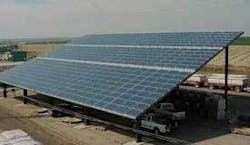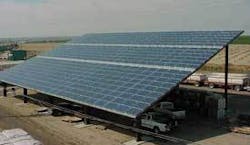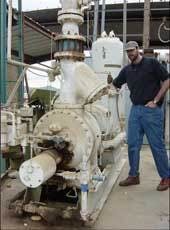Energy Management: No Small Potatoes!
by Mike Breslin
• Solar-Hydro System at Potato Processing Plant Reports Performance, Payback after Four Years of Operation
“It’s kind of like a water ride at Disneyland, only the passengers are potatoes,” says Peter Belluomini, vice president of farming operations for Lehr Brothers Inc., one of California’s largest growers and processors of potatoes. That’s how he describes his company’s potato processing facility in the state’s San Joaquin Valley that packs out approximately 900,000 hundredweight of potatoes - 9,000,000 lbs. - annually.
A Bold Experiment
Technologically, the potato processing industry underwent a major transformation in March of 2003 when Lehr cut the ribbon on a new solar system that provides 119 kW for an average of 565 kW hours per day of electricity from 10,000 square feet of photovoltaic panels mounted on two raised structures next to the plant.
This first-of-its-kind installation was designed and installed by WorldWater & Solar Technologies Corp., a New Jersey company that in 2002 patented its AquaMax technology, a breakthrough solar system capable of driving standard, three-phase motors and water pumps up to 1,000 horsepower while instantaneously blending grid and solar electricity. Driving a hybrid solar-grid 350 hp compressor pump for hydro flow and cooling was obviously a bold move for Lehr and agribusiness.
“It’s working well because you don’t have to think about it. It pretty much takes care of itself because it doesn’t require a lot of maintenance or effort to keep it running. It’s just there making electricity and putting it back into the grid,” said Belluomini.
But ease of operation was just one benefit, as Lehr’s real objective was to reduce operating costs and maximize profits. To understand how solar power entered the equation, you should know about Lehr’s business and how the cost of California energy and environmental regulations affected it.
Lehr Operations
Near Bakersfield, the Lehr facility operates up to 10 months a year processing potatoes grown on over 3,000 acres of farms. Most of these farms are owned and operated by Lehr which does business as Big “L” Packers, but the company also has joint venture growing partners in neighboring areas of the San Joaquin Valley, as far south as the Imperial Valley and up in the high desert east of the facility. These farms keep the processing plant, known as a “shed” in the industry, busy most of the year processing and packing varieties such as long whites, reds, Yukon golds and russets, which mature at different times due to planting time and the various climates.
After the potatoes are harvested from the field, they’re delivered in bin trailers to the Lehr processing plant for cleaning, sizing and packaging. When the bins arrive at the loading dock, a large arm with a high pressure hose swings out and the potatoes are literally blasted by water out of the trailers into receiving troughs. Potatoes, which float, then flow downstream in a water system through a series of tumblers which remove field dirt and sanitize them. After water treatment, the spuds arrive at conveyor belts that carry the produce through sizing chains and across grading tables where hand graders remove rejects, grade the products and pack them in 5-lb. bags, 50-lb. cartons, or 100-lb. sacks.
Hot Potato!
Most of the year, the solar-powered recirculating water systems runs at ambient temperature, but during the heat of the summer Lehr uses refrigerated water during processing to remove heat from the potatoes. In July in the San Joaquin Valley, if you stick a thermometer into a potato, the interior temperature could be 90°F or higher. At 90°F, shelf-life for potatoes isn’t very long, so Lehr’s hydrocooling system reduces temperatures to 45°F to 50°F before packing to maximize freshness and shelf life. It’s easy to see why having reliable solar electricity to chill water during the warmer months is critical to the business.
Crunching Numbers
When you’re moving, washing and cooling over nine million pounds of potatoes each year, your electric bill takes a big bite out of your business. Before Lehr installed the solar system, its utility bill was approximately $3,000 a month. That was Lehr’s prime motivation for going to solar, especially when every utility rate increase took another painful nip of its bottom line. California also has a notorious history of brownouts and blackouts that can inconveniently put you temporarily out of business, unless you have backup diesel-powered electric generation. But then you run into constantly increasing costs of fuel plus pollution limitations imposed by the California Clean Air Act that can restrict diesel operation to a few hours a day.
The total cost for the WorldWater & Power solar system was about $900,000 and Lehr’s out of pocket investment about $450,000. The balance was paid in the form of 40% utility rebate, a 10% federal tax credit and a 7.5% California tax credit. Many other state utilities have liberal rebate programs and allow farmers, businesses and homeowners to “bank” unused solar-generated electricity for later use, as required, thorough “net metering.” In other words, the solar electricity generated and not consumed by Lehr is sent back into the grid to earn credits.
Since Lehr installed its system, the average monthly utility bill has been “zero” and those savings go towards recouping its investment. “A short time ago we ran the numbers again,” said Peter Belluomini, who is also a recent past president of the Kern County Farm Bureau. “We estimated that it would be closer to a total of 10 years to recover our entire investment. That means in six to seven years we’ll be free and clear, generating our own free electricity and contributing to company profits. Since the expected life of the components is 25 to 30 years, we could be getting free power for 15 to 20 years after that.”
Other Benefits
Besides looking to a future of free electricity in a few years and always having reliable solar power, WorldWater’s technology is also providing Lehr Brothers with other advantages. The AquaMax system improves motor and pump operating efficiency with variable speed operation and soft start-stop control extends motor life. The raised photovoltaic structures also provide much-needed shade for farm equipment storage and maintenance in the hot Bakersfield sun.
Mechanics especially appreciate the shade. Keeping the solar panels clean for maximum efficiency has been less of a problem than originally anticipated and plans for a regular washing program were abandoned. They found calcium and salts in the water caused water spots more detrimental than dust. In winter, there’s enough rainfall to keep the panels clean; and, in summer if it gets too dusty, they wash it down a few times with a fire hose - solar powered, of course.
Mike Breslin is a New Jersey-based freelance writer. WorldWater & Solar Technologies Corp. has its headquarters in Pennington, NJ. Contact: 609-818-0700 or www.worldwater.com



